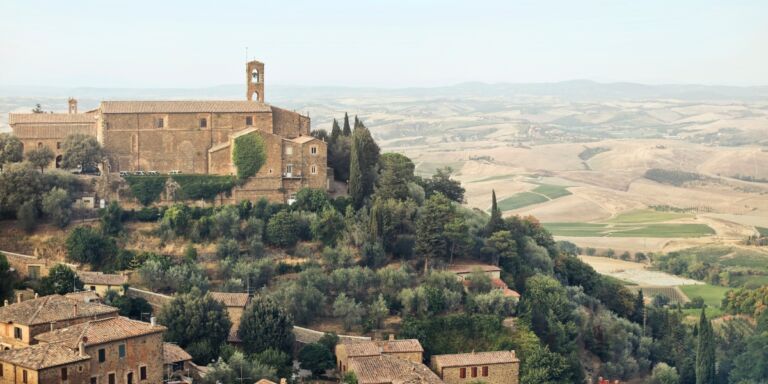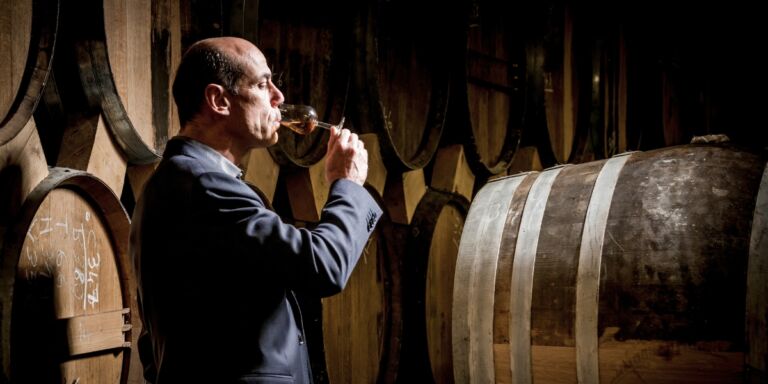We’d started the morning in a sheep traffic jam. My group was in a small town in the Peruvian Andes at 3,000m and, once the sheep had moved, we’d driven further into the mountains to hike up to a piercingly blue lake at the foot of a volcano. Our drivers then carefully guided the cars down a winding dirt road. What felt like an endless number of switchbacks later, the road released us into the Majes Valley, a green oasis in the middle of the desert.
It was sunset by the time we pulled up to a pisco distillery called Cepas de Loro. There, Bougainvillaea flowers framed an open courtyard, surrounded by buildings where Peru’s national spirit was in different stages of production. Owner and general manager César Uyén led us around the property; first into a damp, dark room full of clay vessels, where I felt like I’d stepped back in time. In many ways, I had.

Pisco has been produced in this area for at least four centuries. When the Spanish conquistadors invaded Peru in the 1500s, their demand for wine prompted the importation of Spanish grapes to the New World. Vinification was left to the Jesuits, who then gave the grapes they didn’t use to local farmers. These farmers began making aguardiente, or firewater, a grape spirit similar to brandy except distilled only once and never aged in wood.
The majority of aguardiente for export went through a port called Pisco, the word for bird in Quechua (the local indigenous language). Eventually the spirit took this name too. From the 17th century onwards, pisco production spread not only across Peru but also Chile. The two countries maintain a pisco rivalry to this day, arguing over whose grape varietals, terroirs and production methods – Chilean pisco is aged in different shaped stills and can be distilled multiple times – are superior.

Inside the room that he called a replica of a 19th-century bodega, Uyén pointed to where people used to smash grapes with their feet outside, so that the must would pour down a little slide through the window into a basin, from which it was distributed into the clay vessels, called tinajas, for fermentation. We soon traded the ancient world for the modern one, entering a well-lit room where a yeasty smell clouded the air. Uyén explained that the technological advancements Cepas de Loro uses are only those that also improve the quality of the pisco. ‘Our goal is not to be the biggest producer,’ he told us, ‘it’s to create the best-tasting product.’ He pointed out the steel casks where the grape spirit is fermented before it’s transferred to traditional brick and copper stills for distillation. Next, we approached the large plastic vats where the pisco is aged. It’s essential to lift the top off these vats each day to let oxygen in; what Uyén called giving the pisco a little saludo (greeting).
Peru and Chile maintain a pisco rivalry to this day, arguing over whose grape varietals, terroirs and production methods are superior
When it came time to sample Cepas de Loro’s piscos (puro made from one grape variety, acholado made from two or more, and mosto verde made from partially fermented grape must), Uyén led us through the process like a dance. He asked that we appreciate how the pisco ‘shines like a diamond’ in the glass before instructing us to let it ‘caminar por la boca’ (walk through the mouth). Of all the piscos we tried, a puro made of Muscat grapes stood out. Its aroma was so intensely floral that each time I lifted the glass to my face it was like sticking my nose into a rose bush. Drinkers may appreciate a well-made Pisco Sour but tasting pisco on its own gives a deeper appreciation for the spirit.

Not only is pisco the national spirit of Peru but it’s also the pride of the Majes Valley. Cepas de Loro is just one producer along the Ruta del Pisco, a tourism route established in 2004 to bring visitors to some of the country’s most storied vineyards. There are three branches of the Ruta del Pisco: the southern route, the central route (which includes the Majes Valley), and the northern route, each highlighting the various flavours and terroirs of Peru’s official pisco-growing regions. Most of the distilleries along the route offer tours and some even have lodging and on-property restaurants to encourage stays. Some welcome tourists to participate in harvest celebrations in February.
Speaking to Uyén and the owners of other pisco distilleries reveals that each bodega along the route has its own family legacy. La Tinaja de Oro, located an hour north of Cepas de Loro, was founded by a couple who fell in love and ran away together to realise their dream of starting a vineyard. Marques de Torán, one of the oldest bodegas along the route, established in 1589, is rumoured to be in possession of a special Spanish tinaja dating back to the year 816. Meanwhile, Majes Tradición (the producer responsible for the formation of the Majes Wine and Pisco Association, as well as the annual Shrimp, Pisco and Wine Festival of the Majes Valley) is on its 11th generation of wine and pisco makers.

Marco Zúñiga Diaz, who currently runs Majes Tradición, says it’s ‘a great commitment’, to be one of the oldest continuously producing pisco families in Peru. He carries on the family business while relying on orgullo (pride), which he says ‘forces us to always be at the forefront [of the industry], while also maintaining traditions.’ It seems that all the pisco producers in the Majes Valley share this sentiment. Mario Melendez Calmet, owner of Marques de Torán, calls pisco production ‘a passion that we carry in our blood, from our ancestors,’ saying that pisco has become ‘a symbol of identity.’
In the Majes Valley, pisco production isn’t just ‘an art form’ but also a way to keep history alive
Uyén showed this passion as he led us around Cepas de Loro; proudly standing next to his product, leading us through the tasting with great care – his affection for the craft creeping into the language he used to describe his pisco. Here in the Majes Valley, pisco production isn’t just ‘an art form,’ as Uyén calls it, but also a way to keep history alive. As Calmet put it to me, the business is ‘our cultural heritage – a way of tending to our love of tradition, which makes all Peruvians proud.’








